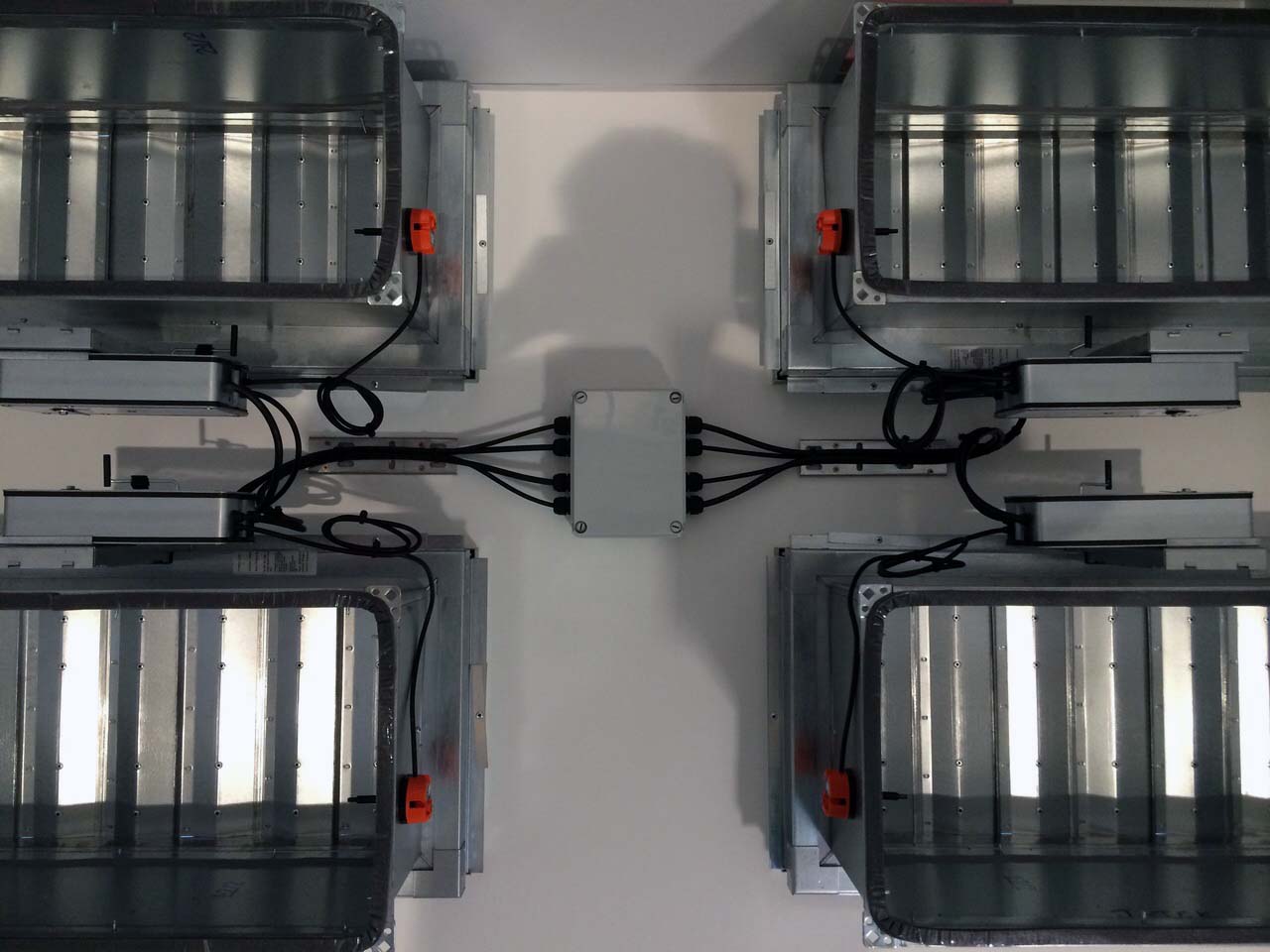Fusible Link and Motorized Fire Dampers: Ensuring Fire Safety
Understanding fire dampers and their functionality is essential in maintaining the safety of your building. At J-Tek, we specialise in two critical types of fire dampers: Fusible Link Fire Dampers and Motorised Fire Dampers.
Fire dampers form part of a building ventilation system and are installed where air handling ducts pass through fire-separating elements such as compartment walls or enclosures protecting escape routes.
Typically, a fire damper is a metal curtain within a duct held up by a thermal element (referred to as a fusible link) and released in the event of a rise in temperature. The thermal element will melt at a set temperature releasing a spring-operated metal curtain, which is pulled down to fill the opening the duct passes through, preventing the passage of fire.

Motorised Fire Dampers
Fusible Link Fire Dampers
Motorised fire dampers are specifically designed for installation in HVAC ductwork at fire barrier or fire & smoke barrier locations. They are instrumental in preventing the spread of fire or smoke in residential, commercial, and industrial buildings. These dampers operate with the help of actuators, which can be electric or pneumatic. They are controlled through heat detector signals, fire alarms, or building control systems.
Fusible links come in various shapes, sizes, and temperature ratings, typically triggered at 72°C. When they reach their rated temperature, they release the damper blades, allowing the damper to shut, sealing off the firewall where the ductwork penetrates through. This effectively prevents the spread of fire (and smoke in the case of Fire & Smoke dampers) through the ductwork.
Regular testing is essential for ensuring functionality. These dampers can be part of a comprehensive "Fire strategy" and are used to ventilate pressurised escape routes.
Motorised fire dampers are engineered for efficiency, effectiveness, and reliability. They effectively isolate fire zones, ensuring clear access routes for firefighting in the event of a fire.
Even when the HVAC system is turned off, these dampers provide protection against fire and smoke spread. The thermal fusible link within these dampers automatically closes in response to high temperatures, and in case of power failure, dampers equipped with pneumatic actuators return to the closed position. Connecting the damper for remote monitoring and regular testing is essential for ensuring its functionality. These dampers can be part of a comprehensive "Fire strategy" and are used to ventilate pressurized escape routes.
Maintenance and Testing?
Fuse Finks & Actuators play a pivotal role in the functionality of fire dampers, their maintenance is equally important to ensure the proper operation of fire dampers during a fire incident.
Responsibilities for Testing and Maintenance
As the building owner or responsible person on-site, you must ensure that all fire and smoke dampers within your building are located, serviced, and tested regularly.Neglecting this responsibility could lead to legal consequences. The Regulatory Reform (Fire Safety) Order 2005 places the onus on employers to maintain their fire safety systems. Testing and maintaining fire dampers are essential for fire safety, and regulations like BS 9999 Annex W.1 Inspection and Maintenance specify the need for regular checks by competent persons.
Testing Fire Damers
At J-Tek, we offer a comprehensive range of services to ensure your fire and smoke dampers comply with the British Standard 9999:2017 Code of Practice for Fire Safety in the Design, Management, and Use of Buildings. All fire and smoke dampers are rigorously tested by our highly trained and competent engineers.
Testing
- An inventory of all dampers to be tested.
- Manual release of all fire/smoke dampers to verify the integrity of the spring-loaded shutter.
- Inspection of the fusible link for any deformity or damage.
- Cleaning and lubrication of the fire/smoke damper within the closed position.
- Opening and re-setting of the fire/smoke damper.
- Inclusion of any severe corrosion findings within the service report.
Reporting
- An inventory of all fire dampers
- Explanation of any failed operation.
- Recommended corrective or remedial actions.
- Any fire dampers that did not pass during testing will be re-tested after remedial action is taken.
What is a Drop Test?
During a fire damper drop test the operative will:
- Manually released the fusible link and allow the curtain and drop into closed position.
- Ensure the damper curtain closes fully, visually checking that the bottom curtain blade locks onto the locking-ramp.
- The fusible link will be inspected for any deformity or damage.
- Whilst in close position the damper will be cleaned and lubricated (if advised in manufacturer maintenance manual).
- Damper shall then be opened and re-set, ensuring the bottom blade remains parallel with the top of the damper.
- Photographic evidence will be taken of the damper in the ‘as found’ position, close position and reset position.